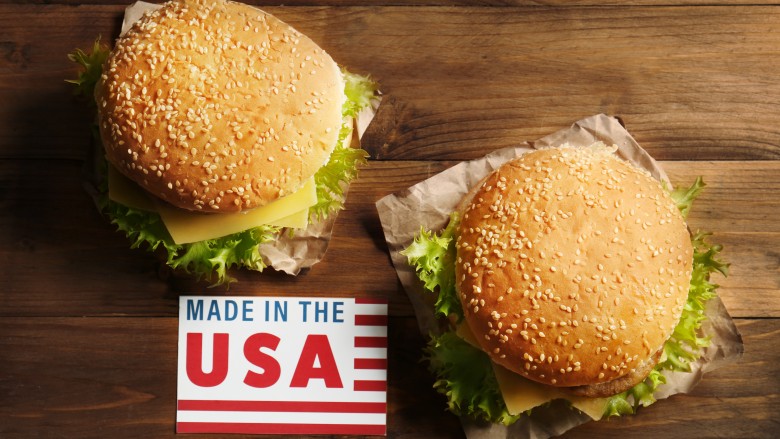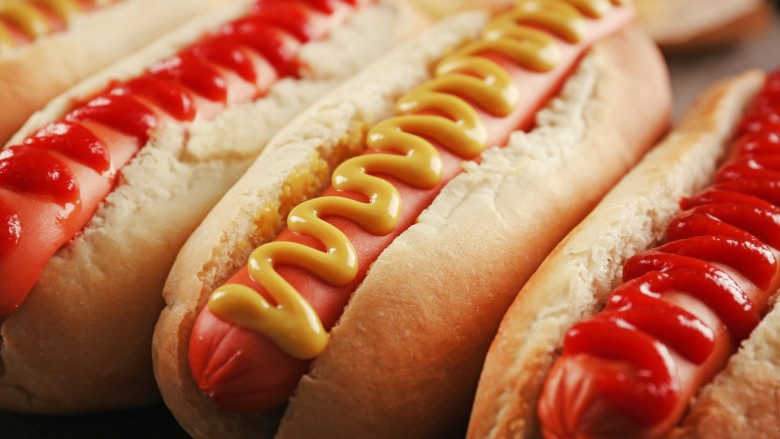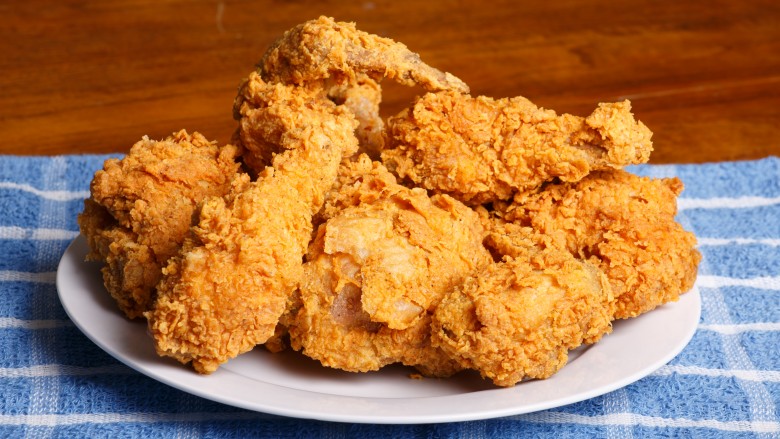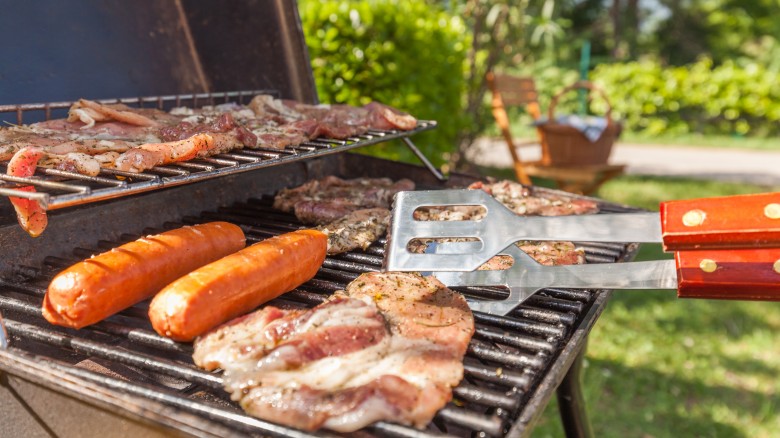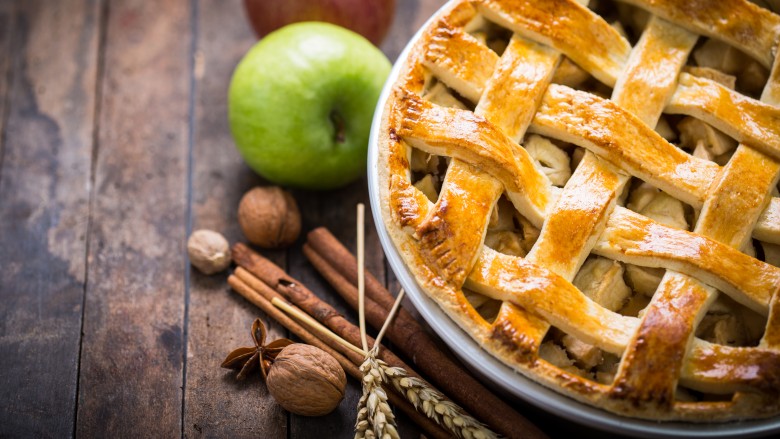Foods You Always Thought Were American But Aren't
Some foods are easy to place into a national origin. (Like Spam. Only Americans could invent something so disgusting.) But we can't lay claim to as many American classics as we might like. Here are some dishes you always thought were true-blue American. Spoiler alert: you're wrong.
Hamburgers
Ask any American kid what type of food is truly American in origin and most of them would probably point right to hamburgers. The American fast food industry was built upon the hamburger and the dish has come a long way since the first McDonald's opened its doors in 1937. People had been placing meat between slices of bread for centuries before the so-called "hamburger" was actually invented and its origin is somewhat muddied through history. The most likely origin of both the modern take on the hamburger as well as its name may have originated from the Hamburg-America shipping line, which is thought to have brought the recipe of the Hamburg steak from Europe to the United States at the end of the 19th century.
Food stands sprouted up all over the ports and harbor of New York City at this time offering "steak cooked in the Hamburg style." This wasn't exactly the hamburger we know today. It was shredded beef of a relatively low grade seasoned with regional spices brought over from Germany. The meat would be served either cooked or raw and could be placed between two pieces of bread for easy handling and consumption, but lacked the traditional slice of cheese, lettuce, pickle, tomato, and onions common today.
The name of the hamburger was likely derived from the location of its origin, though we don't know for sure. Since the end of the 19th century, the hamburger has evolved from the relatively simple combination of bread and meat into what we know today. Though it didn't begin in the States, it has become synonymous with American cuisine. And we haven't changed much: billions and billions of hamburgers have been served in America, proving that people everywhere have loved low-grade, barely seasoned beef for at least the last two centuries.
Ketchup
You can't begin an article about American food with hamburgers and not talk about the one condiment burgers can't do without! Ketchup is ubiquitous in the United States and can be found on the tables of restaurants throughout the entire country. If a truly American condiment exists, it is ketchup. Watch any movie where an American goes to Europe and asks for ketchup to see just how much ketchup and Americans are associated with one another. But ketchup wasn't invented in the United States — it came out of Southeast Asia.
First, let's look at the name. "Ketchup" is a rather odd word in the English language. That's because it comes from the Chinese word "ke-tchup" (also "kôechiap" or "kê-tsiap") which is the name of a sauce derived from fermented fish. It was first brought from Vietnam to China where the British likely encountered it sometime in the 18th century. When the British brought over the recipe, they changed it significantly from the brine-like concoction used in Asia to one more palatable to their cuisine. They would include anything from walnuts to mushrooms and bits of anchovies and would add them to soups and other sauces. All of this was happening before anyone thought to mash up the one ingredient modern ketchup can't do without: the tomato.
It wasn't until 1812 that the first tomato ketchup recipe was first published. The recipe was created by horticulturist James Mease. People liked his idea, and ketchup exploded in popularity. One of the reasons it eventually became so popular was its ability to be stored for up to a year. This was thanks to the large quantity of vinegar added by none other than Henry J. Heinz in 1876. From that point, ketchup has been pretty much the same recipe and it became a commercial success. Today, 97 percent of Americans have said they have some in their refrigerators. If only we could get 97 percent of the country to agree on ... literally anything else.
Hot dogs
Found at baseball games across the United States, the hot dog is truly an American classic that is enjoyed by millions the world over, year after year. Unfortunately for American pride, the hot dog is decidedly not an American invention. Sausages are said to have originated in the kitchens of Emperor Nero during the Roman Empire, but may have come about even before that. The modern hot dog or frankfurter actually originated in modern-day Germany and Austria. The proud cities of Vienna and Frankfurt each claim ownership of the hot dog, named Vienna sausages and frankfurters, to this day.
Frankfurt claims the frankfurter was first invented in the city all the way back in 1484. Vienna claims the sausage originated from its city and points to the common name of wiener, a derivative of Wien (the Austrian spelling of Vienna). Whether or not either of these claims are accurate, it's apparent that the hot dog did not find its origin in the United States. The modern hot dog is more likely an amalgamation of various sausages made by different nationalities, which is appropriate considering they are something of an amalgam of whatever animal parts are lying around.
It wasn't until the late 19th century that the hot dog as we know it arrived in America. The first Coney Island hot dog stand opened in 1871 and sold more than 3,600 hot dogs in its first year of business. Since then, it has become a staple of American foods. Heck, they're practically the only reason most people go to baseball games anymore.
Peanut butter
Ask any American who invented peanut butter and they might incorrectly identify George Washington Carver, who developed more than 300 uses for the peanut (though only 105 of them were meant for human consumption). But Mr. Carver definitely didn't invent peanut butter. It's been around since as early as 1500 B.C., when Incans ground peanuts to make peanut butter and other useful items.
From South and Central America, peanuts and peanut butter were taken to Spain by European explorers. Peanuts then spread to Asia and Africa, and Africans brought peanuts to North America sometime in the 1700s. Peanuts weren't a commercial product in the United States until the next century thanks, in large part, to P.T. Barnum's circus, which sold hot roasted peanuts to the crowds that came to see the Greatest Show on Earth. This was all before peanut butter became a product in the United States. Processes for making peanut butter date as far back as 1884 in Canada and 1895 in the United States when Dr. John Harvey Kellogg patented a process for making it from raw peanuts. Before it was introduced as a commercial product at the St. Louis World's Fair in 1904, a physician named Dr. Ambrose Straub patented a peanut butter-making machine so he could provide the paste to patients in need of a protein substitute. Peter Pan peanut butter entered the market in 1928, and Skippy soon followed in 1932.
Peanut butter became well known as an American product due to its use in military rations during World War I and World War II. GIs would combine peanut butter with jelly to make something every American schoolkid has found in their lunchboxes at one time or another. Plenty of very reasonable adults still pack a PBJ in their own lunches every day.
Doughnuts
Like most of the foods found on this list, the doughnut has a somewhat muddled history without a great deal of certainty about its history. When did doughnuts first come to the States? And who punched the first hole? The modern doughnut with a hole in the middle might just be an American innovation, but the cakes themselves were nothing new when they first hit North America thanks to Dutch immigrants settling into New Amsterdam — modern New York City. They brought with them their recipe for the olykoek, or "oily cake," and they've been contributing to our growing waistlines ever since.
The fried cakes continued in relative obscurity for centuries until Elizabeth Gregory, the mother of a 19th-century New England ship captain, fashioned a type of cake for her son to take on voyages. She would mix up the dough and place either a hazelnut or a walnut in the center where the dough didn't fully cook through. She gave them the rather literal name of doughnuts, and the name stuck. Her son, Captain Gregory takes the credit for putting a hole in the middle of the dough and later said he was responsible for "the first doughnut hole ever seen by mortal eyes." Some claimed he did this to keep the cake on the spoke of the ship's wheel while navigating, but never claimed such colorful details himself.
The doughnut became ingrained with American culture in the trenches of World War I, when millions of the tasty treats were served to the Yanks by volunteers who made them to help alleviate their homesickness. It wasn't until after the war that doughnuts really caught on with the invention of the first doughnut machine in 1920. From that point, the doughnut became much easier to produce, and shops sprouted up all over the country. The modern doughnut may have an American twist to it, but we can all thank the Dutch for bringing the delicious cakes to the New World.
Fried chicken
Nothing evokes the cuisine of the U.S. South like some delicious fried chicken, so it's no surprise that people often think the meal started in the United States. In fact, fried chicken dates back at least a few centuries: the Scottish would pan-fry chicken in animal fat. The idea either spread to other cultures or was independently created around the same time in West Africa as well as other areas of the world.
The popular dish was brought to the American South eventually, but you can choose which origin story you want to believe. It was either brought to the New World by enslaved West Africans or by Scottish migrants. At any rate, someone combined their methods with those of the people living in the American South to make the modern dish we know of today. The main difference between fried chicken from the South and others from history is the addition of breading or batter, which is so common in modern recipes that it's difficult to find the dish without it.
The cost of chickens steadily declined over the centuries, which has helped to make this dish as common as it is today. While fried chicken may not have originated in the U.S., many would say it was perfected here. Munch on.
Barbecue
It might be tough to swallow, but barbecue does not find its origin in the United States. Barbecue (a method of cooking, not a specific dish) isn't just throwing meat onto a grill. It's all about grilling meat for an extended period of time over indirect heat, most often provided by a wood fire. The flavor resulting from cooking for a long period of time (like 18-24 hours) infuses the meat with a unique flavor brought by the smoke, meat juice, fat, and the spices added prior to and during cooking.
The barbecue method and style of cooking comes from the Caribbean islands. When the Spanish met the indigenous population there, they used the word "barbacoa" to refer to the Caribbean method of slow-cooking meat. Caribbean natives and Spanish explorers brought the style of cooking to what would eventually become the United States. From there, it developed into various styles and different methods to include the creation of barbecue sauces and dry rubs. It's easy to assume barbecue is an American creation due to its incredible popularity in much of the country. But like most things in the U.S., barbecue was a borrowed idea.
Turkey
Every American schoolkid has heard the story of how the English settlers to the New World were saved by generous Native Americans in what is now called the first Thanksgiving in 1621. These historical inaccuracies aside, it is widely believed that Native Americans in North America were the first to bring the delicious bird to the table. Well, not really!
People were eating turkey as far back as 800 B.C. The indigenous people of what is now Mexico enjoyed the bird since at least that time. The fossil record indicates that's when the bird was domesticated and eventually moved north around 200 B.C. where it was further domesticated by another indigenous group of people. The Native Americans who would eventually go on to assist the English colonists with their knowledge of corn and other edible vegetables were likely introduced to turkey as a part of their diet around 1100. Up until that point, they may have used turkeys primarily for their feathers rather than their meat.
Due to their large size and the taste of their meat, the turkey was easily adapted into the diets of the colonists who settled the Americas, and it has remained a central aspect of the Thanksgiving dinner since around 1863 when President Lincoln declared it a national holiday and gave it a regular date. The turkey was favored for this particular meal due to its size. It could feed an entire family, and it kept raunchy Uncle Ed's mouth too full for him to talk, which is the real blessing of Thanksgiving.
Apple pie
Nothing says American like apple pie, right? A good apple pie calls you back to the old days of American growth and prosperity where you might imagine a Norman Rockwell painting of a loving mother doting on her children with a sweet slice of cinnamon-dusted Americana. But apple pie didn't originate in the U.S. Apples and pie were married to one another long before the first colonists set sail for the New World and were likely joined hundreds of years earlier in Europe and Asia.
The oldest surviving apple pie recipe was published around 1390 in a cookbook given to Queen Elizabeth. The recipe called for apples to be accompanied with figs, raisins, pears, and a pastry shell, called a coffin at the time. Sugar, which was expensive and difficult to come by, was not used in the recipe. The pastry was intended more as a vessel for shoveling the baked fruits into your mouth.
Sugar was more readily available in the 1500s, so the pastry dough got upgraded. When English colonists found only crab apples in the New World, they brought their own apples around 1620. Apples and sugar, now being much easier to obtain in the Americas, found their way into American stomachs and onto American windowsills. So maybe Americans didn't invent the apple pie, but at least we invented Walmart so we could buy apple pies for a dollar or two.

